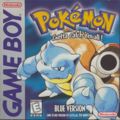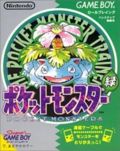Pokémon: Red, Green and Blue Versions
  
| |
| Pokémon: Red/Green/Blue Versions | |
| Developer | Game Freak |
| Publisher | Nintendo |
| System | Game Boy, 3DS Virtual Console |
| Release Date | Red Version JP February 27, 1996 US September 30, 1998 EU October 7, 1999 Green Version JP February 27, 1996 Blue Version JP October 16, 1996 US September 30, 1998 EU October 7, 1999 3DS Virtual Console All Regions: February 27, 2016 |
| Rating | ESRB: E |
Pokémon: Red Version, Pokémon: Green Version and Pokémon: Blue Version are a set of monster-collecting handheld RPGs that act as the initial three games of the Pokémon series and make up the series' first generation. The game was made in several different versions in order to increase interactivity between gamers (as gamers would have to trade Pokémon with each other in order to collect all of the game's monsters).
Story[edit]
The game follows the story of a young trainer from Pallet Town who aspires to become a Pokémon master. To do so, this trainer must defeat eight Pokémon gym leaders and collect their badges in order to reach the Pokémon League Headquarters in Indigo Plateau, where he can challenge the Elite Four. Along the way, this trainer must compete with his rival, foil the nefarious plans of Team Rocket and catch as many of the 151 Pokémon hidden throughout the land as possible.
Gameplay[edit]
The game was an RPG in which the player had to collect and raise various Pokémon creatures, which were primarily used in battles. There were two different types of battles. In field battles (similar to the random battles usually found in RPGs), the player could either defeat the wild Pokémon for experience or capture it to add it to his or her collection. The other type of battles was with another Pokémon trainer, in which the goal was to defeat all of the trainer's Pokémon. Pokémon could also be taught special abilities that could be used outside of battle to reach new places. Some examples include the Surf technique, which was the only way to travel over water, or the Fly technique, which could be used to travel instantly to different areas of the world map.
Connectivity[edit]
Using the Game Boy Link Cable, games could be connected so that the Pokémon could be traded or used in battle between the two games. Some Pokémon could only be obtained through trade: Pokémon that were exclusive to one version as well Pokémon that could only evolve by being traded. There were also several points in the game were the player had to choose one out of two or more Pokémon to own (such as in the beginning, where the trainer must choose between a Bulbasaur, Squirtle or Charmander), and the Pokémon not chosen could then only be obtained by trading with another player.
Pokémon could also be transferred into the games through Nintendo representatives; this was the only method of acquiring Mew, the hidden 151st Pokémon, without use of glitches or cheating devices.
The original Pokémon games could also be linked with Gold and Silver for trade after their release; however, the Gold and Silver players could not trade any of the new Pokémon introduced in those games, nor could they trade Pokémon that knew any of the new moves introduced in Gold and Silver. Finally, these games could be linked to the Pokémon Stadium games on the Nintendo 64, where the Pokémon could be used in 3-D battles, and several unique Pokémon with special moves could be unlocked.
Version Differences[edit]
In Japan, the Red and Green Versions were the first two to be released. The main difference between both versions was that certain Pokémon could only be found in one of the versions. Pokemon: Blue Version was later released as a version featuring a graphical update.
In America, the Red and Blue Versions were released simultaneously. Both games featured the graphical update of the Japanese Blue Version. The American Blue Version also had the same Pokémon as the Japanese Green Version, making it some strange combination of the two.
Legacy[edit]
These games helped to fuel the Pokémon phenomenon which gripped America in the later 1990's. It also inspired various spin-off games such as Pokémon Stadium and Pokémon Snap.
Remakes/Rereleases[edit]
- In 1999 a fourth version, Pokémon: Yellow Version was released. This version contained more alterations to the game, most of which incorporated elements of the popular Pokémon anime series.
- The original two games were remade for the Game Boy Advance in 2004 as Pokémon: FireRed and LeafGreen Versions.
- In 2017. Red and Blue (as well as Green In Japan) were made available for download through the Nintendo 3DS's eshop as part of the 3DS Virtual Console. These ports were only slightly modified - some of the flashier animations were toned down, and the Nintendo 3DS wireless communication was used for connectivity in place of the Link Cables. The Poké Transporter app could also be used to transfer Pokémon caught in these versions to the Poké Bank, from which they could be brought to other Pokémon games.
- In 2018, Pokémon: Let's Go, Pikachu! and Let's Go, Eevee! were released for the Nintendo Switch. These acted as partial remakes of the first generation games, based specifically on the Yellow version, but with some new characters and gameplay alterations.
Sequels[edit]
These games were followed up by the second generation games, Pokémon: Gold and Silver Versions. These games further expanded the world of Pokémon and added one hundred new creatures while also revisiting the characters and locations from the Red/Green/Blue/Yellow games (including Red himself).
| Mainstream titles of the Pokémon Series |
|---|
| I: Red/Green/Blue (Yellow - FireRed/LeafGreen - Let's Go, Eevee/Pikachu!) - II: Gold/Silver (Crystal - HeartGold/SoulSilver) III: Ruby/Sapphire (Emerald - Omega Ruby/Alpha Sapphire) - IV: Diamond/Pearl (Platinum - Brilliant Diamond/Shining Pearl) - V: Black/White (2) VI: X/Y - VII: Sun/Moon (Ultra) - VIII: Sword/Shield - Pokémon Legends: Arceus - IX: Scarlet/Violet |